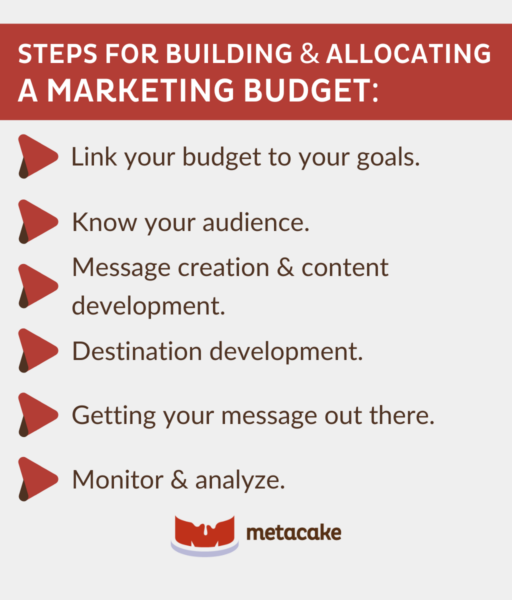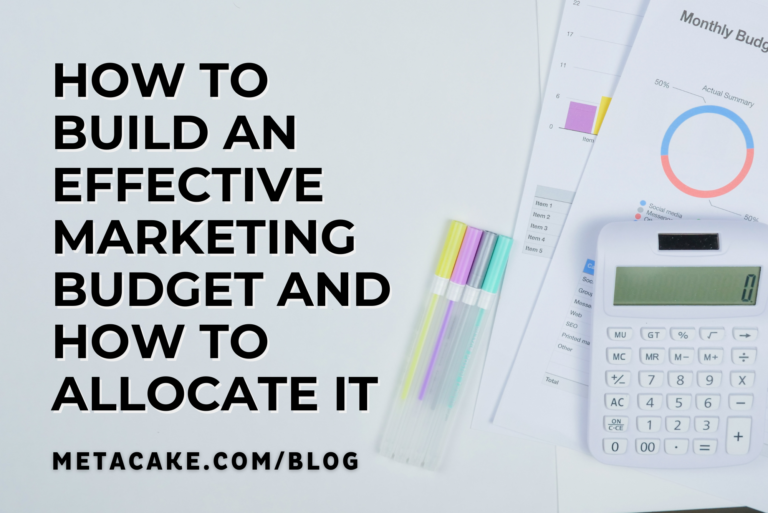If you’ve ever worn a headband, you know how uncomfortable they can be. The small teeth dig into your scalp, the band creates an annoying pressure behind your ears, and you spend the whole day readjusting so it doesn’t make your hair look weird (or so we’ve heard).
But the team at Banded, an ecommerce shop and a recent client, believed in the accessory’s potential. They created a versatile, painless headband that’s now the cornerstone of their successful company.
Banded’s founders created their product to solve a problem, which is where all good marketing strategies begin. The problem defines your goals — what are you trying to solve and how are you going to do it — and from there, you can develop and sell a quality product.
But you’re not finished just yet. You need a marketing budget, and you need to know the best practices for allocating that budget.

Building and Allocating a Marketing Budget
Now that you’ve begun your marketing strategy, you’ve solved a problem and defined your goals. What’s next? Let’s look at some best practices for allocating your marketing budget.
As you start to build your marketing budget, it’s important to remember that there’s no map that guarantees success. Sure, some elements may appear on every business’ journey, but you’re going to reach different chasms and bends in the road than the other guys.
Don’t worry too much about what they’re doing. Instead, use these steps to focus on devising a strategy that works for your company.
Link Your Budget to Your Goals
Before you dive into the specifics of your budget, you must identify what you’re trying to achieve. What kind of business do you want to run? How much do you plan to earn? The answers to these questions define your goals, and your goals dictate your budget.
Strategy is at the core of everything you do in business. It provides the roadmap that tells you how to get where you want to go and how much money you’ll need to spend to get there. You can’t have an effective budget without a strategy, and you can’t run a strategy without a budget.
If the goal is to make $1 million, a $10,000 budget isn’t going to get you there.
You can’t reach lofty, blue-sky business goals without investing proportionally in what you’re trying to achieve. Really think about your desired outcomes before creating a budget; you don’t want to make it halfway to your goal and run out of money.
A half-baked budget that doesn’t fully support your goals jeopardizes your business because you’re setting yourself up to fall short of your projections. If you’re not willing to invest in making that million or going all in right now, readjust your vision to what seems more feasible budget-wise in the short term.
If you’re starting with limited funds, spend them wisely. Don’t spread what money you do have too thin by targeting every marketing channel. Invest in one or two options that you’re confident will earn you a decent ROI.
Again, your budget and goals must align, so be realistic about your early constraints in order to build momentum. Once you’ve seen success in one or two channels, you can invest some of those earnings into broadening your strategy.
Know Your Audience (Research and Strategy)
If your strategy is a roadmap, think of your product as your mode of transportation. You wouldn’t take an untested vehicle on a cross-country journey, so don’t bring a lackluster product to market.
Our friends at Banded are so confident in their product that they give it away for free at conferences. They let people try out their headbands and ask that they come back and pay only if they’re 100% satisfied. Most people return and gladly fork over their money.
The folks at Branded know they have a great product because they spent years testing and perfecting it. Make sure your product is equally great before you make it the core of your business.
Once you know you’ve got a roadworthy product, identify your target market. Research the best ways to reach your audience, whether that’s through Facebook, Pinterest, or email campaigns. Knowing who you’re targeting creates a foundation for deep profits down the road.
But just knowing who you’re targeting isn’t enough. You need to know where your audience spends their time, and you can then allocate your budget accordingly to make sure you’re reaching them where they are.
Message Creation and Content Development
Once you’ve created a stellar product and know which sites and social media platforms your audience frequents, it’s time to figure out what you’re going to say. Your content and voice should reflect your brand’s personality and the customers you’re targeting.
When you know which marketing channels you’re going to use, you can tailor your message to those platforms. Hire pros, whether in-house or through an agency, to develop your brand’s voice, ad copy, and content strategy.
And make sure your brand voice is consistent across all channels. You don’t want to have a fragmented approach.
Destination Development
Now we’re going to send you packing — for your marketing journey, that is. But instead of travel-sized toiletries and fresh underwear, you’re filling your suitcase with websites, landing pages, and analytics systems.
Many landing pages are designed to capture users’ information so you can engage them with offers and great content, ultimately leading to sales. It’s not enough to have a simple sign-up form promising them intellectual riches or discounts in return for their email addresses. You need contextual landing pages that convey your brand’s character and personality.
A good conversion rate optimization (CRO) strategy insures your marketing strategy on an ongoing basis. Run tests on different copy for your ads and landing pages. If you’re always testing different elements of your campaigns, you can constantly improve customers’ experiences and boost your sales numbers.
A solid analytics system is essential to your CRO. Google Analytics provides you with a lot of valuable information, but if you’re in a niche industry, you should invest in Deep Analytics.
For instance, if you operate in high-end markets such as luxury real estate, you’ll want behavioral analytics that help you cater to that very specific audience.
Getting Your Message Out There
At long last, you’re ready for your bon voyage party, also known as launching your marketing strategy. This includes ad buys, rolling out your social media campaigns, and amping up brand awareness initiatives.
You’re always going to be refining your strategies, coming up with new and creative ways to reach your audience, and building new campaigns for changing technologies.
Look for opportunities to increase brand visibility through partnerships or viral content, and pay close attention to the evolving marketing landscape. You want to know where it’s best to allocate those marketing funds.
Monitor and Analyze
Once your marketing strategy is up and running, monitor your performance across different channels. Use your analytics to pinpoint missed opportunities or exceptional ROIs. Invest more in what’s working and reevaluate your strategy for what’s not.
The marketing journey never ends. Some quarters you’ll sail peaceful, clear-blue seas. Others, you’ll be hiking Kilimanjaro with 100 pounds of equipment on your back, ready to call it quits.
But as long as you’ve got plenty of rations and the right vehicle, you’ll get where you want to be and then some.
How to Build an Effective Marketing Budget and How to Allocate It: Final Thoughts
Knowing how to allocate your marketing budget properly may seem like a “tough row to hoe,” but when you break it all down, it becomes much easier.
Plus, you always have our exceptional team at Metacake to help you every step of the way.
So, if you’d like more information, or maybe just a hand in implementing these budget allocations, feel free to reach out!
